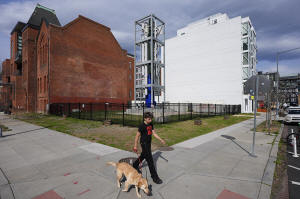New wave of smaller, cheaper nuclear reactors sends US states racing to
attract the industry
[March 29, 2025] By
MARC LEVY
HARRISBURG, Pa. (AP) — With the promise of newer, cheaper nuclear power
on the horizon, U.S. states are vying to position themselves to build
and supply the industry's next generation as policymakers consider
expanding subsidies and paving over regulatory obstacles.
Advanced reactor designs from competing firms are filling up the federal
government's regulatory pipeline as the industry touts them as a
reliable, climate-friendly way to meet electricity demands from tech
giants desperate to power their fast-growing artificial intelligence
platforms.
The reactors could be operational as early as 2030, giving states a
short runway to roll out the red carpet, and they face lingering public
skepticism about safety and growing competition from renewables like
wind and solar. Still, the reactors have high-level federal support, and
utilities across the U.S. are working to incorporate the energy source
into their portfolios.
Last year, 25 states passed legislation to support advanced nuclear
energy and this year lawmakers have introduced over 200 bills supportive
of nuclear energy, said Marc Nichol of the Nuclear Energy Institute, a
trade association whose members include power plant owners, universities
and labor unions.
“We’ve seen states taking action at ever-increasing levels for the past
few years now,” Nichol said in an interview.
Smaller, more flexible nuclear reactors
Smaller reactors are, in theory, faster to build and easier to site than
conventional reactors. They could be factory-built from standard parts
and are touted as flexible enough to plunk down for a single customer,
like a data center or an industrial complex.

Advanced reactors, called small modular reactors and microreactors,
produce a fraction of the energy produced by the conventional nuclear
reactors built around the world for the last 50 years. Where
conventional reactors produce 800 to 1,000 megawatts, or enough to power
about half a million homes, modular reactors produce 300 megawatts or
less and microreactors produce no more than 20 megawatts.
Tech giants Amazon and Google are investing in nuclear reactors to get
the power they need, as states compete with Big Tech, and each other, in
a race for electricity.

States are embracing nuclear energy
For some state officials, nuclear is a carbon-free source of electricity
that helps them meet greenhouse gas-reduction goals. Others see it as an
always-on power source to replace an accelerating wave of retiring
coal-fired power plants.
Tennessee Gov. Bill Lee last month proposed more than $90 million to
help subsidize a Tennessee Valley Authority project to install several
small reactors, boost research and attract nuclear tech firms.
Long a proponent of the TVA's nuclear project, Lee also launched
Tennessee's Nuclear Energy Fund in 2023, designed to attract a supply
chain, including a multibillion-dollar uranium enrichment plant billed
as the state's biggest-ever industrial investment.
In Utah, where Gov. Spencer Cox announced “Operation Gigawatt” to double
the state's electricity generation in a decade, the Republican wants to
spend $20 million to prepare sites for nuclear. State Senate President
J. Stuart Adams told colleagues when he opened the chamber's 2025
session that Utah needs to be the “nation’s nuclear hub."
Texas Gov. Greg Abbott declared his state is “ready to be No. 1 in
advanced nuclear power" as Texas lawmakers consider billions in nuclear
power incentives.
Michigan lawmakers are considering millions of dollars in incentives to
develop and use the reactors, as well as train a nuclear industry
workforce.
One state over, Indiana lawmakers this month passed legislation to let
utilities more quickly seek reimbursement for the cost to build a
modular reactor, undoing a decades-old prohibition designed to protect
ratepayers from bloated, inefficient or, worse, aborted power projects.
[to top of second column] |

A youth walks a dog past a Last Energy prototype of a microreactor
on display at the corner of 10th and V Street NW in Washington,
Tuesday, March 25, 2025. (AP Photo/Pablo Martinez Monsivais)
 In Arizona, lawmakers are
considering a utility-backed bill to relax environmental regulations
if a utility builds a reactor at the site of a large industrial
power user or a retired coal-fired power plant.
Big expectations, uncertain future
Still, the devices face an uncertain future.
No modular reactors are operating in the U.S. and a project to build
the first, this one in Idaho, was terminated in 2023, despite
getting federal aid.
The U.S. Department of Energy last year, under then-President Joe
Biden, estimated the U.S. will need an additional 200 gigawatts of
new nuclear capacity to keep pace with future power demands and
reach net-zero emissions of planet-warming greenhouse gases by 2050
to avoid the worst effects of climate change.
The U.S. currently has just under 100 gigawatts of nuclear power
operating. More than 30 advanced nuclear projects are under
consideration or planned to be in operation by the early 2030s,
Nichol of the NEI said, but those would supply just a fraction of
the 200 gigawatt goal.
Work to produce a modular reactor has drawn billions of dollars in
federal subsidies, loan guarantees and more recently tax credits
signed into law by Biden.
Those have been critical to the nuclear industry, which expects them
to survive under President Donald Trump, whose administration it
sees as a supporter.
Supply challenges and competition from renewables
The U.S. remains without a long-term solution for storing
radioactive waste, safety regulators are under pressure from
Congress to approve designs and there are serious questions about
industry claims that the smaller reactors are efficient, safe and
reliable, said Edwin Lyman, director of nuclear power safety at the
Union of Concerned Scientists.
Plus, Lyman said, “the likelihood that those are going to be
deployable and instantly 100% reliable right out of the gate is just
not consistent with the history of nuclear power development. And so
it’s a much riskier bet.”
Nuclear also has competition from renewable energies.
Brendan Kochunas, an assistant professor of nuclear engineering at
the University of Michigan, said advanced reactors may have a short
window to succeed, given the regulatory scrutiny they undergo and
the advances in energy storage technologies to make wind and solar
power more reliable.
Those storage technologies could develop faster, bring down
renewables' cost and, ultimately, make more economic sense than
nuclear, Kochunas said.
The supply chain for building reactors is another question.

The U.S. lacks high-quality concrete- and steel-fabrication design
skills necessary to manufacture a nuclear power plant, Kochunas
said.
That introduces the prospect of higher costs and longer timelines,
he said. While foreign suppliers could help, there also is the fuel
to consider.
Kathryn Huff, a former top Energy Department official who is now an
associate professor at the University of Illinois Urbana-Champaign,
said uranium enrichment capacity in the U.S. and among its allies
needs to grow in order to support reactor production.
First-of-their-kind reactors need to get up and running close to
their target dates, Huff said, "in order for anyone to have faith
that a second or third or fourth one should be built.”
All contents © copyright 2025 Associated Press. All rights reserved |